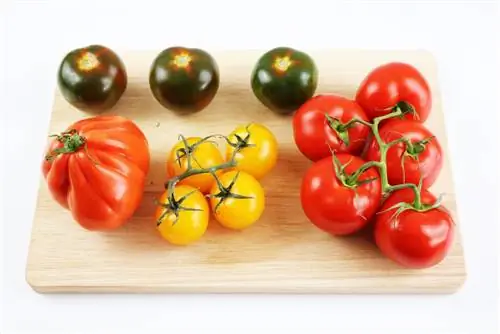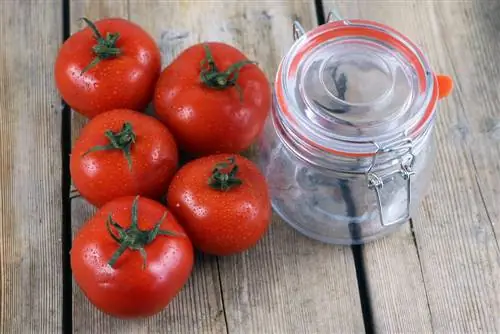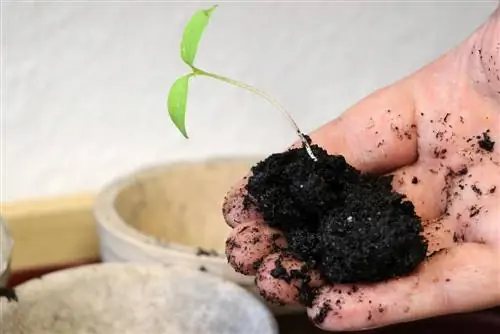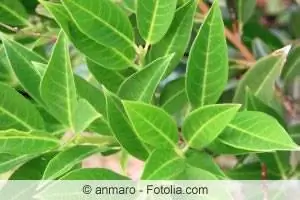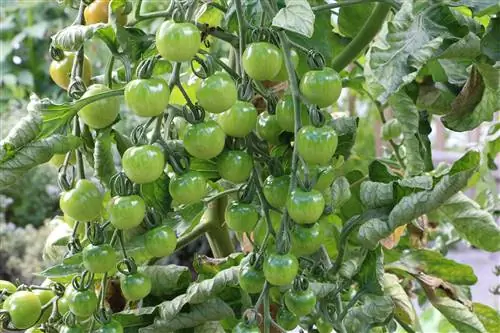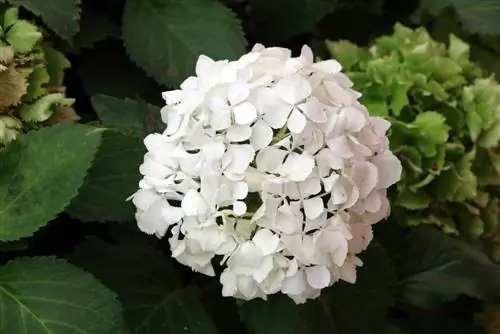- Author admin [email protected].
- Public 2023-12-17 03:39.
- Last modified 2025-01-24 12:45.
If you want to reward yourself for the effort of growing tomatoes with a rich harvest, you have to give the nightshade plants the necessary attention. It is important to pay attention to the correct fertilization of the tomatoes.
Tomatoes are heavy feeders
For tomatoes to grow well, they must have a sunny spot and moist soil. But a good tomato harvest also requires regular, nitrogen-rich fertilization. The nitrogen stimulates leaf growth. Phosphorus and potassium are important for the fruits. This applies equally to potted tomatoes and outdoor tomatoes. Before you buy a tomato fertilizer, you should examine the soil structure of the tomato bed. If the soil is filled with humus-rich substances, such as homemade compost, which can consist of leaves or grass clippings, you don't actually need tomato fertilizer. Because this natural and ecologically produced fertilizer cannot replace artificial fertilizer.
But not everyone has a composter and so two types of fertilizer should be considered. A fast and a slow acting fertilizer. Which one you add doesn't actually matter for the growth of tomatoes. By the way, fertilizer, whether purchased or made yourself, strengthens the resistance of tomatoes and protects them from pests and diseases. If you decide to use purchased fertilizer, you should buy your tomato fertilizer from a specialist retailer. This is already mixed and has the right ingredients.
- In addition to potassium, tomato fertilizer should primarily contain nitrogen, phosphate and magnesium oxide.
- Four weeks after planting the tomato plants, a complete fertilizer can be worked into the root area.
- Approximately 50 grams per plant is required.
- You can fertilize after four weeks.
Tomatoes need a lot of nutrients, especially potassium and other minerals. If you decide to have a bed with tomatoes, you should create it in the fall and cover it with compost. The tomato plant likes humus and thrives in it. The tomato needs potassium in particular so that it gets the wonderful red color and grows well. If there is a potassium deficiency, you notice it quickly. The edges of the leaves become paler and the fruits ripen at different rates. The gardener can also use a special tomato fertilizer for other vegetables, such as cucumbers and zucchini.
The right dosage when fertilizing makes the difference
When buying tomato fertilizer, you should pay attention to the fact that the nutrient content of the soil is different. The dosage advice given on the packages is based on the average content. For clay soils that are already rich in nutrients, the amount of fertilizer can be halved. You should also pay attention to the correct amount when fertilizing. If you fertilize too much, the leaves develop strongly, but the fruits remain. In order to avoid overdosing when fertilizing, you should fertilize more often with a low dosage. Plants that require a lot of light also need more fertilizer.
The best time to fertilize is early in the morning and when the sun is not shining. If you fertilize when the sun is shining, the leaves and roots can burn, especially if the soil is dry. A fast or slow acting fertilizer can be applied as desired. You can fertilize the tomatoes traditionally with liquid fertilizer but also with powder, grains, drops or sticks. A 5 kilo pack of tomato fertilizer costs around 10 euros.
The alternative fertilization of tomatoes
As an alternative to purchased ready-made fertilizer, the tomatoes can also be fertilized organically and naturally. There are several ways to do this: manure, for example, can be easily set up. This organic fertilizer is particularly suitable for fertilizing tomatoes:
- Horse manure
- Compost
- Horn shavings
- Stinging nettle manure
- Comfrey Manure
- Cow dung
Production of nettle manure for organic fertilization
Stinging nettle manure, for example, is relatively easy to make. To make it you need gloves, scissors, water and a plastic bucket. Metal buckets are not suitable as chemical reactions can occur between the nettle and the metal. Pour the nettle into the bucket, fill it lightly and do not squeeze it tightly. Gloves should be worn. All parts of the plant can be used for this purpose, except the flowers. The filled bucket is then filled with water; all parts of the plant should be covered. Then cover it with a wire rack to prevent animals from entering the bucket and potentially drowning. The nettle manure must be stirred once a day so that enough oxygen is supplied to the manure. It is stirred until the south begins to ferment, which can be noticed by the formation of bubbles and by the hearty scent.
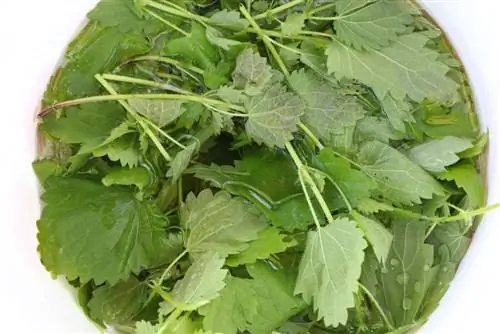
The process can last up to a week, after which the fermentation process is finished and the manure can be used. For the young plants, start with a mixing ratio of one part manure and 20 parts water. I.e. 10 liters of water and half a liter of manure. If the tomato has already grown vigorously, the nettle manure can also be administered in concentrated form. The tomato receives a particularly potassium-rich fertilization when the manure is mixed with comfrey. Then the mixture is diluted 1:10 and brought to the root ball; the leaves are to be excluded. Horse manure and horn shavings can also be used as fertilizer for the tomatoes.
If you want to grow good-tasting and juicy tomatoes, you have to fertilize them to get a reasonable yield. The tomato fertilizers available in specialist stores often have a mineral base. This type of fertilizer stimulates the growth of the tomato but does not improve its taste. An organic fertilizer is better for fertilizing tomatoes, it gives the plant strength and brings the distinctive full flavor.
What you should know about tomato fertilization in brief
- A tomato plant grows to a height of approx. 1.30 m to 1.70 m and produces its tomatoes from summer until late autumn.
- Tomatoes should first be grown indoors and planted out into the garden at the beginning of the warm season (May).
- From June to August, the tomato plant has yellow flowers, which later ripen into the popular tomatoes.
Since the tomato plant is very sensitive, it should be protected from heavy rain. To do this, you should place foil over the tomato plant. Depending on their size, tomatoes are divided into beef tomatoes, party tomatoes, cocktail tomatoes and bottle tomatoes. Party tomatoes are tomatoes of the smaller genus and can therefore also be planted on the balcony. A tomato consists of 95% water and is therefore very low in calories.
Tomatoes require a lot of nutrients. They are heavy eaters. The soil should be composted generously in autumn, as tomatoes love humus-rich soil. In order to obtain large plant yields, i.e. to grow delicious tomatoes, the tomato plant must be fertilized regularly from the beginning of planting until harvest. Since the plants are very sensitive, they need a nutrient solution that is tailored to the tomato plant, and they also have to work quickly because the tomato plants grow very quickly.
- You should use a specific tomato fertilizer as it is enriched with potassium.
- Potassium promotes the growth of the tomato plant as well as fruit formation and ripening.
- Potassium also makes the plants more resistant to pest infestation. If the plants lack potassium, this is noticeable by earlier wilting or by the plant leaves rotting from the outside in.
- Organic fertilizers include: nettle manure, horse manure or cow dung.
- Tomato plants also like a mixed drink made from one part whole milk and three parts rainwater.

